The keto diet is a high-fat, low-carbohydrate eating plan that has gained popularity for its potential to promote weight loss and improve overall health. By drastically reducing carbohydrate intake, the body is forced into a state of ketosis, where it burns fat for fuel instead of glucose. While the types of food consumed on a ketogenic diet are crucial, the quantity—which is where portion control comes into play—is equally important.
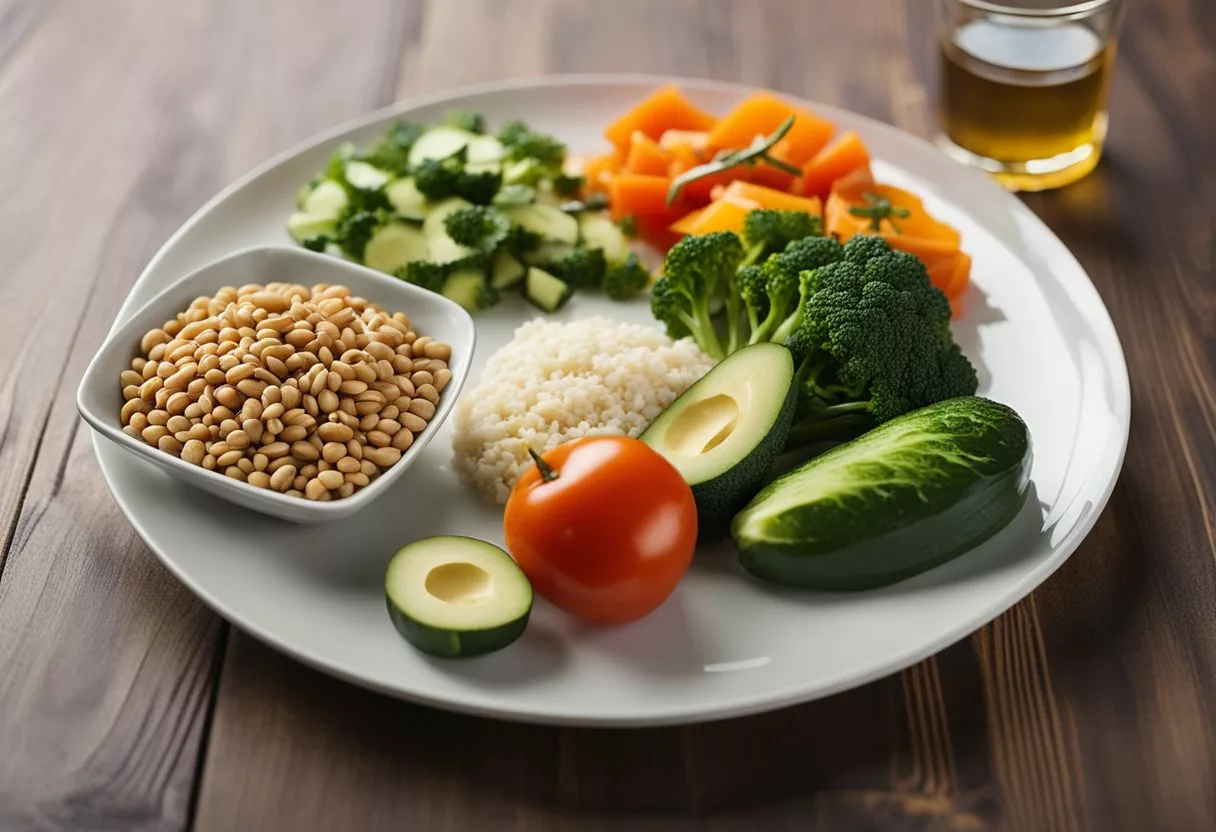
Portion control is an essential aspect of the ketogenic diet, especially for those aiming to lose weight. It isn’t just about choosing the right kinds of fat and protein but also about consuming them in the correct amounts to maintain a calorie deficit. Eating too much of even the permitted foods can hinder progress by providing too many calories, which may stall or even reverse weight loss efforts.
Understanding the principles of portion control can help individuals on a ketogenic diet to better regulate their food intake. This can ensure that they are not exceeding their daily carbohydrate limit, generally around 20 to 50 grams per day, which is essential to stay in ketosis. Adhering to portion guidelines also allows for a balanced diet within the keto framework, ensuring an appropriate intake of nutrients while managing calorie consumption.
Understanding Ketosis and the Keto Diet
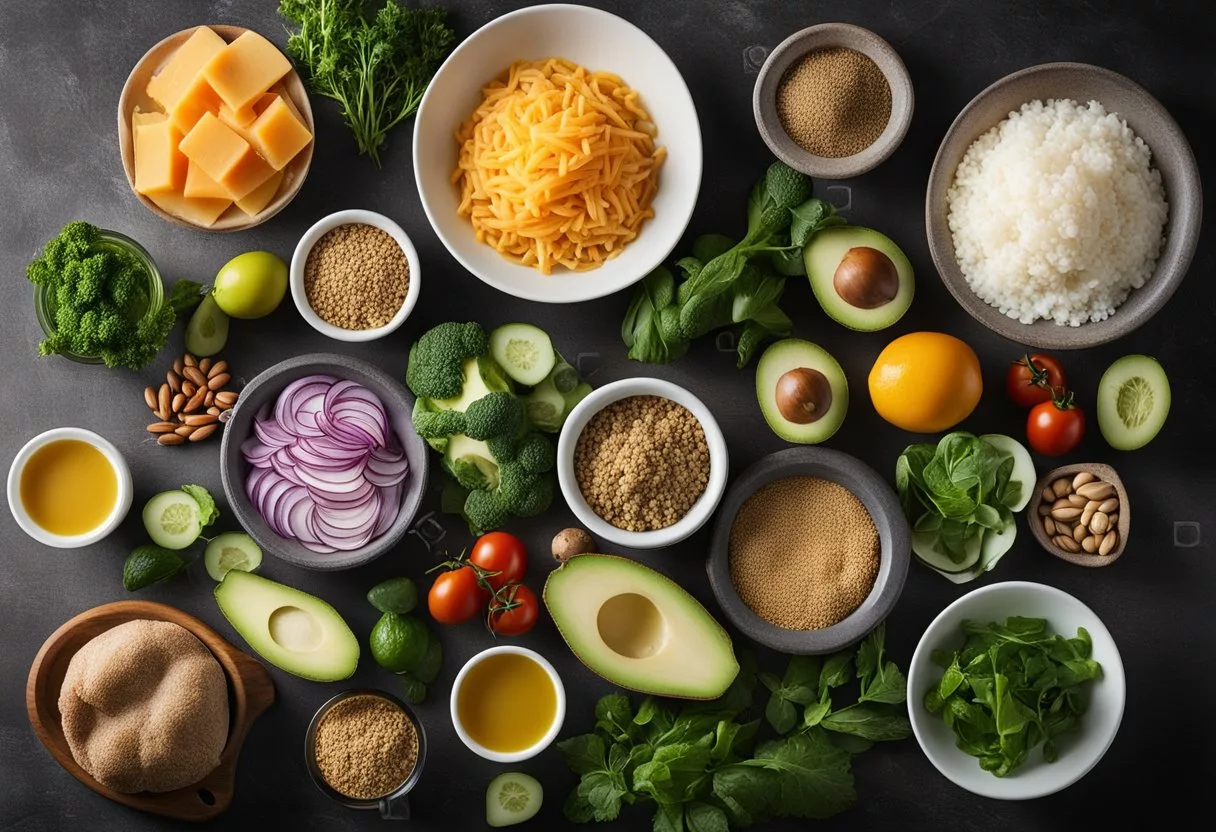
To effectively manage portion control on a keto diet, it is essential to comprehend the underlying principles of ketosis and the diet’s structure. These include the metabolic state of ketosis achieved through macronutrient manipulation and the diet’s emphasis on fat, moderate protein, and minimal carbohydrate intake.
Defining Ketosis
Ketosis is a metabolic state where the body utilizes fat for fuel instead of carbohydrates. When one severely limits carb intake, the liver converts fat into fatty acids and ketone bodies, an alternative energy source. These ketones then serve as fuel for the body and brain. Achieving ketosis typically requires one to consume fewer than 50 grams of carbohydrates per day, though this number can vary per individual.
Basics of the Keto Diet
The keto diet focuses on high fat consumption, adequate proteins, and low carbohydrates. Macronutrient distribution for a standard ketogenic diet is approximately:
- 70-80% calories from fat
- 20-25% from proteins
- 5-10% from carbohydrates
To maintain ketosis, individuals monitor their macronutrient intake, often aiming for about 30 to 50 grams of net carbs daily. Net carbs are total carbohydrates minus fiber. The body’s shift to burning fat for energy can lead to weight loss and can help in managing blood sugar levels, benefiting individuals with diabetes when done under medical supervision.
The Importance of Portion Control on Keto
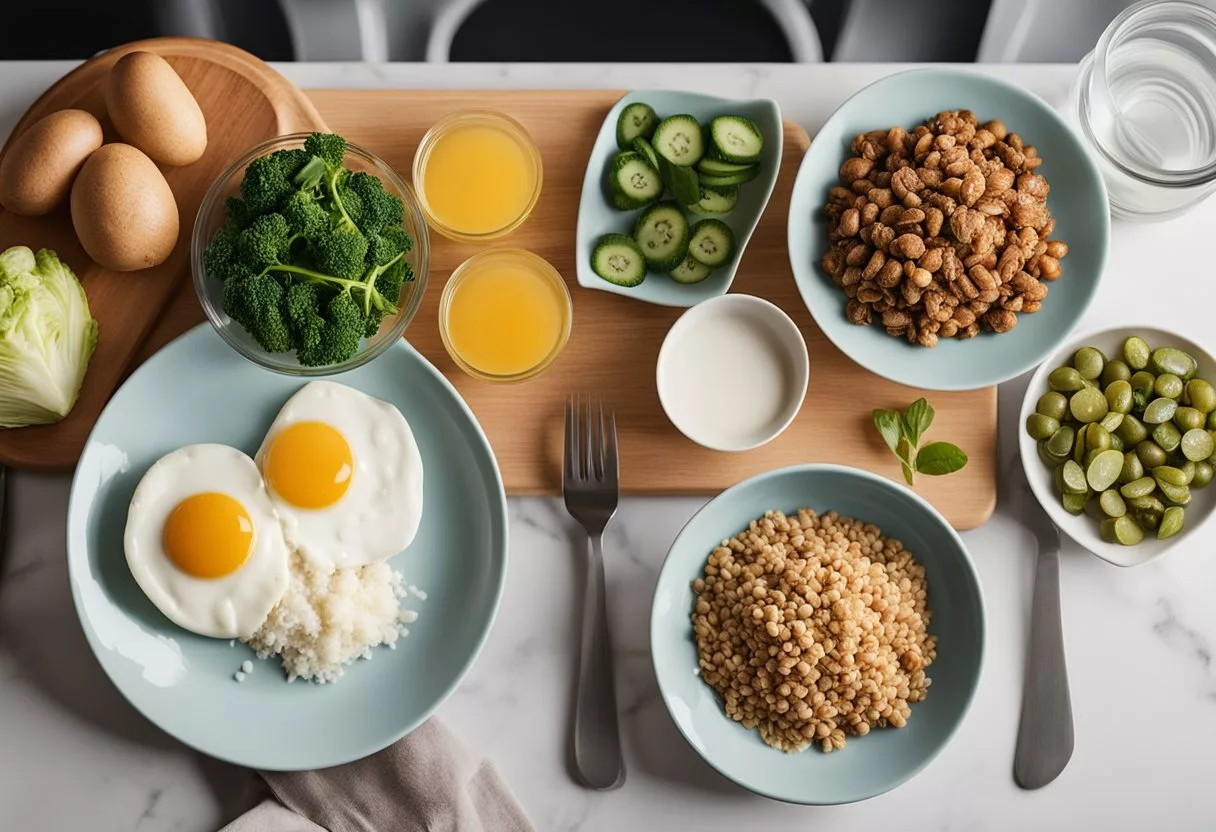
Portion control on a ketogenic diet ensures that one stays within their required caloric intake and helps maintain an effective balance of nutrients, specifically fats, proteins, and carbohydrates.
Managing Caloric Intake
On a ketogenic diet, the body transitions from using glucose as its primary energy source to burning fat for fuel, a state known as ketosis. Caloric intake still matters in this metabolic state because consuming more calories than the body expends can lead to weight gain. Even though the diet is high-fat, portions need to be managed to maintain a caloric deficit for weight loss or a balance to sustain weight. Proper portion control allows individuals to stay within their daily calorie goals while still enjoying the benefits of a keto-adapted metabolism.
- Daily calorie goals: Varies by individual
- High-fat consumption: Approximately 70-80% of total calories
- Portion sizes: Adjusted to meet energy expenditure
Avoiding Overconsumption of Proteins and Carbs
Keeping protein and carb consumption in check is critical on the ketogenic diet. It’s important to monitor protein portions because overconsumption can lead to gluconeogenesis, where the body converts excess protein into glucose, potentially disrupting ketosis. Carbohydrate intake is typically limited to about 30 grams per day, and precise portion control helps avoid accidental overconsumption which can also interrupt the delicate balance of ketosis.
- Protein guidance: Moderate intake, about 20-25% of total calories
- Carbohydrate limit: No more than 30 grams per day
- Nutrient balance: Maintaining ketosis through careful portioning
Macronutrients and Their Role in Keto
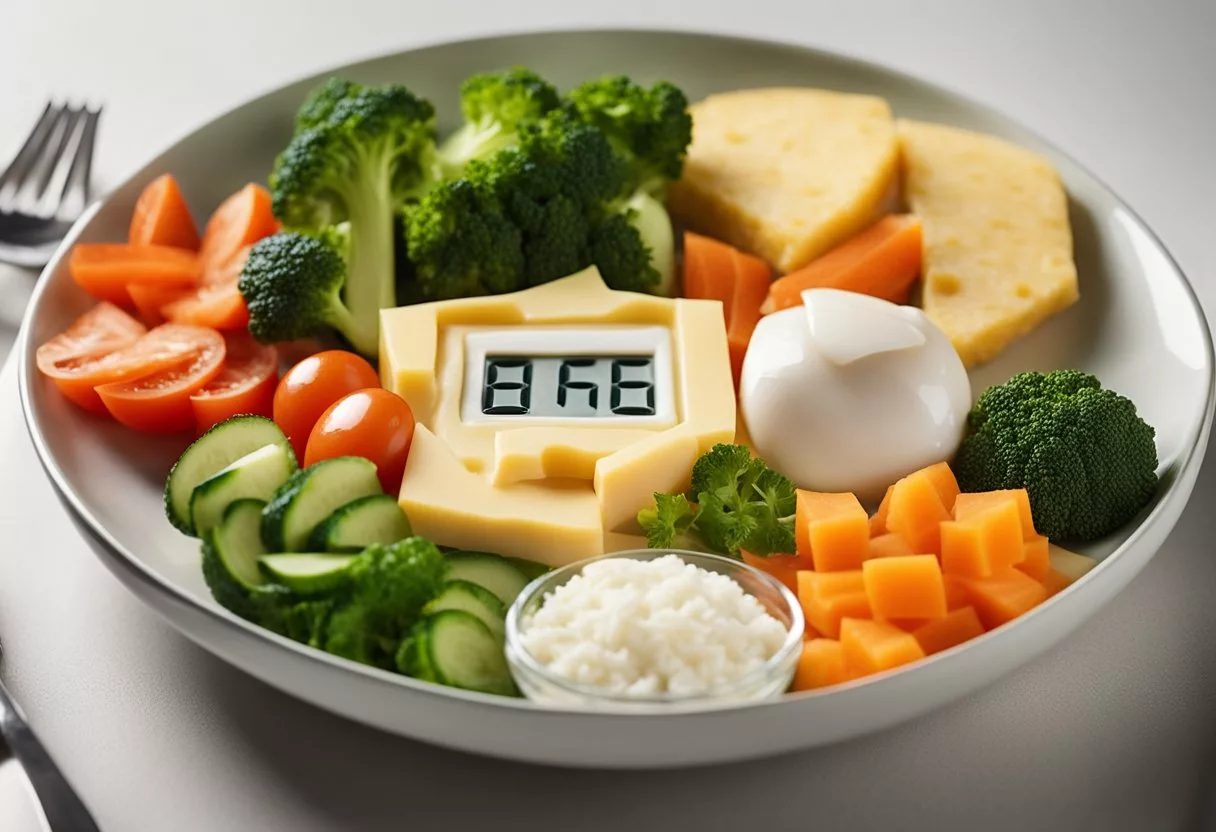
In a ketogenic diet, the distribution of macronutrients is manipulated to shift the body’s primary energy source from carbohydrates to fats. This section examines the roles of fats, proteins, and carbohydrates and their specific contributions to achieving and sustaining ketosis.
Fats
Fats are the cornerstone of the ketogenic diet, typically making up 70-80% of total daily calories. They are essential for entering ketosis, where the body burns fat for energy due to low carbohydrate intake. Healthy fat sources include:
- Avocado oil
- Coconut oil
- Grass-fed butter
- Ghee
- MCT oil
- Olive oil
It is crucial to prioritize these fat sources to maintain energy levels and support overall health on a keto diet.
Proteins
Proteins are the building blocks of the body and should account for 20-25% of daily caloric intake on a keto diet. They are important for preserving muscle mass, especially when the body is in a state of ketosis. Protein sources should be:
- Lean meats (chicken, turkey, lean beef)
- Fish and seafood
- Eggs
- Dairy products (cheese, yogurt)
Consumers should monitor protein intake to avoid excessive consumption, which may interfere with ketosis.
Carbohydrates
Carbohydrates are significantly limited in a ketogenic diet, typically representing only 5-10% of daily calories. To monitor and control carb intake, individuals should understand the difference between total carbs and net carbs:
- Total Carbs: The overall amount of carbs in food.
- Net Carbs: Total carbs minus fiber and certain sugar alcohols.
Staying within the carb limits by counting net carbs is vital for maintaining ketosis. Emphasis is on low-carb vegetables and minimal amounts of low-glycemic fruits.
Keto-Friendly Foods and Portion Sizes
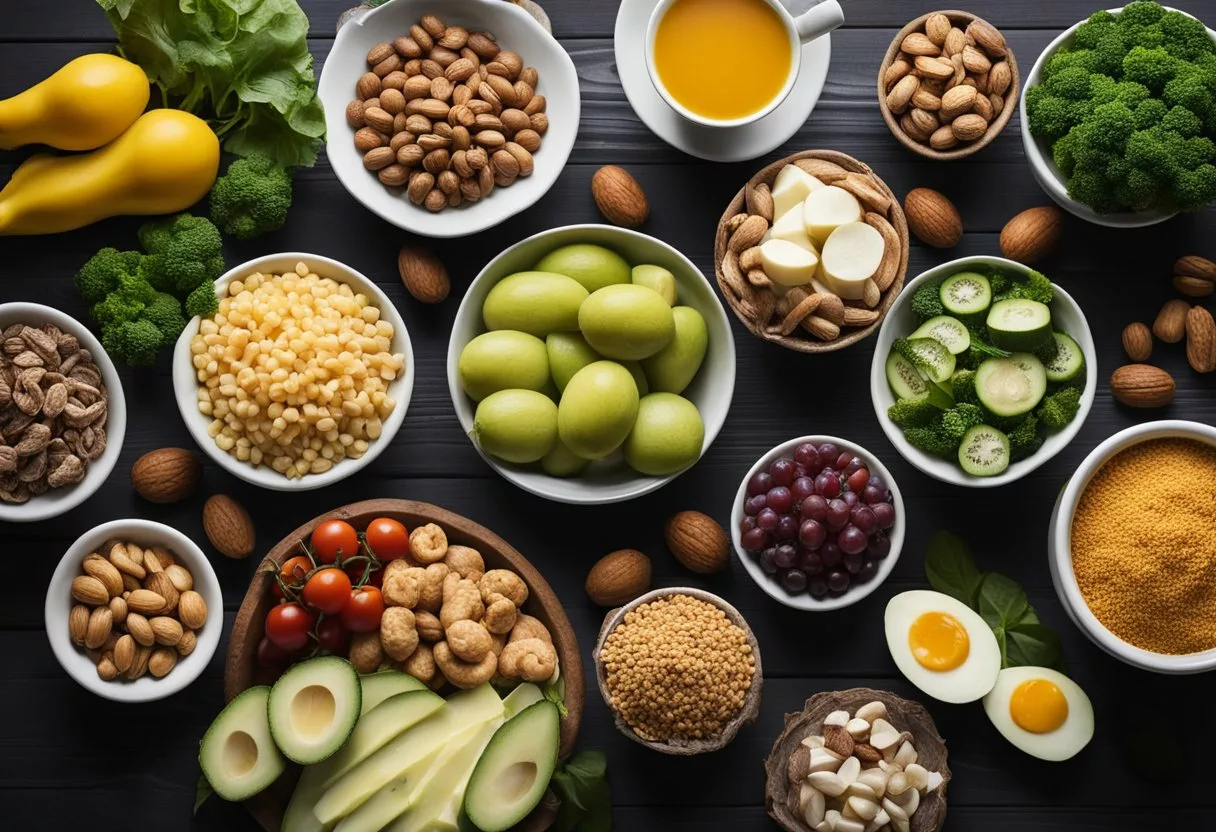
When embarking on a keto diet, understanding the quantity and type of food to eat is crucial for maintaining ketosis. Proper portion sizes of high-fat, moderate-protein, and low-carb foods facilitate the dietary balance necessary for keto success.
Meats and Fatty Fish
Meats are a staple in the keto diet, providing essential protein and fats. It is recommended to consume 3-6 ounces of meat per meal. Fatty fish such as salmon and mackerel are rich in omega-3 fatty acids, supporting a keto diet with roughly 4-6 ounce servings.
Low-Carb Vegetables
Low-carb vegetables are pivotal in a keto diet for their fiber and micronutrient content without significantly impacting carb intake. The ideal portion is 1-2 cups of vegetables like spinach, kale, and broccoli per meal.
- Spinach, Kale: 1-2 cups per serving
- Broccoli, Cauliflower: 1-2 cups per serving
Nuts and Seeds
Nuts and seeds are dense in nutrients and a great source of healthy fats. However, due to their high-calorie count, portions should usually be limited to a small handful, or about 1 ounce.
- Almonds, Walnuts: 1 ounce per serving
- Chia seeds, Flaxseeds: 1 ounce per serving
Dairy Choices
Dairy on a keto diet should be high in fat and low in carbs. Cheese and full-fat dairy can be included, keeping in mind that cheese should be measured to about 1-2 ounces per portion, while other dairy items like heavy cream can be used in moderation.
- Cheese: 1-2 ounces per serving
- Full-fat yogurt, Heavy cream: Use in moderation
Meal Planning and Recipes
Successful meal planning on a ketogenic diet involves a careful balance of macronutrients, ensuring meals are keto-friendly and align with your specific carb limit goals. Recipes chosen should support the meal plan’s framework and contribute to the overall success of your dietary objectives.
Creating a Balanced Meal Plan
In constructing a balanced meal plan, one must prioritize the proportions of fats, proteins, and carbohydrates to adhere to ketogenic principles. Typically, a meal plan on a keto diet keeps net carbs to less than 20-50 grams per day.
To start:
- Breakfast: might include eggs cooked in butter with avocado and spinach.
- Lunch: could be a salad with leafy greens, a generous portion of a fatty protein like salmon, and a keto-friendly dressing.
- Dinner: might feature a portion of grilled chicken with a side of roasted broccoli doused in olive oil.
Meal Prep Tips:
- Cook in Bulk: For example, grilling multiple chicken breasts at once to save time.
- Use Leftovers Smartly: A dinner’s leftover protein can be tomorrow’s salad topping.
Keto Recipes for Success
Keto recipes often require creativity to replace high-carb ingredients with low-carb alternatives. Almond flour or coconut flour can substitute traditional flour, and sugar replacements like stevia or erythritol help keep desserts keto-friendly.
Sample Keto-Friendly Recipes:
- Breakfast: Chia Seed Pudding with unsweetened almond milk and a dash of cinnamon.
- Lunch: Zucchini Noodles with pesto and grilled shrimp.
- Dinner: Cauliflower Crust Pizza topped with cheese and a variety of vegetables.
Each recipe should match the individual’s daily macronutrient targets, ensuring that the meals collectively keep within the net carb limit while providing sufficient protein and fats. It is essential to use precise measurements and consider the nutritional content of each ingredient within these recipes to maintain the integrity of the meal plan.
Understanding Net Carbs and Total Carbs
In managing carbohydrate intake on a ketogenic diet, discerning between total carbs and net carbs is crucial because they influence the body’s metabolism and ketosis status differently.
Counting Net Carbs
Net carbs refer to the carbohydrates that the body actually digests and turns into glucose. They are the focus on a ketogenic diet because they impact blood sugar levels and, consequently, ketosis. One calculates net carbs by subtracting dietary fiber and sugar alcohols from total carbs because the body does not fully absorb these. For example:
- Total Carbs: 20 grams
- Minus Fiber: 5 grams
- Minus Sugar Alcohols: 2 grams
- Equals Net Carbs: 13 grams
Many ketogenic diets recommend staying within 20-30 grams of net carbs per day to maintain ketosis.
Impact of Fiber on Carbs
Dietary fiber is a form of carbohydrate that the body cannot convert into digestible glucose, meaning it has minimal direct impact on caloric intake and blood sugar levels — key factors in ketogenic diets. Fiber can be soluble or insoluble, with both types playing a significant role in digestive health:
- Soluble Fiber: Dissolves in water and can help with blood glucose control.
- Insoluble Fiber: Does not dissolve in water and aids in maintaining bowel health.
Fiber is subtracted from total carbohydrate counts because it largely passes through the digestive system without being digested, making net carbs a more accurate reflection of a food’s effect on ketosis.
Strategies for Portion Control
When adopting a ketogenic diet, employing effective portion control strategies is crucial. They not only help maintain the low-carb thresholds essential for ketosis but also support moderation and balance in daily food intake.
Visual Cues and Tools
Visual cues serve as practical guides for portion sizes. Individuals can use household items or standard measurements to identify appropriate serving sizes. For instance:
- Vegetables: A serving is roughly the size of a baseball or about half a cup of leafy greens.
- Proteins: A visual comparison to a deck of cards can represent a single serving of protein like chicken or fish.
- Fats: Healthy fats, pivotal in a keto diet, such as oils or cheeses, can be measured as the size of a pair of dice.
Using measuring tools like scales, measuring cups, or spoons ensures precision in portion control. This is particularly important on a keto diet where moderation of certain macronutrients, like carbohydrates, is essential to remain within the desired carb limits, typically around 20-30 grams per day.
Mindful Eating Practices
Mindful eating practices encourage awareness of hunger cues and promote eating with intention. Key practices include:
- Before eating, individuals should rate their hunger on a scale from 1 to 10. This helps them recognize true hunger versus emotional eating.
- They should take time to chew food thoroughly, which aids digestion and provides the brain adequate time to recognize satiety.
By engaging in mindful eating, they become more attuned to their body’s needs, reducing the likelihood of overeating. This respectful attention to the body’s hunger and fullness signals is a cornerstone of effective portion control on a ketogenic diet.
Maintaining a Balanced Ketogenic Lifestyle
A balanced ketogenic lifestyle integrates proper nutrient intake with personal habits, ensuring that individuals meet their health goals while adhering to low carbohydrate limits.
Incorporating Healthy Fats
Keto Diet largely focuses on fats as the primary calorie source. To maintain a balanced keto lifestyle, one should prioritize healthy fats like avocado, nuts, seeds, and olive oil. These contain monounsaturated and polyunsaturated fats which are essential for heart health and help to keep hunger at bay.
Staying Hydrated
Hydration is critical on a ketogenic diet as the body adjusts to carbohydrate restriction. Individuals should aim for at least 8 glasses of water per day to support metabolism and help the body process higher fat intake. Carrying a water bottle can be a practical reminder to stay hydrated throughout the day.
Adjusting for Physical Activity
Physical activity is an important part of any lifestyle. Those on a ketogenic diet might need to slightly increase their intake of carbs before prolonged or intense physical sessions. They should focus on low-glycemic index carbohydrates to provide energy without disrupting ketosis. Post-exercise, incorporating protein can help support muscle recovery.
Dealing with Common Challenges
In managing portion control on a keto diet, individuals often face obstacles such as navigating dining in restaurants, controlling persistent cravings, and pushing through periods of stalled progress.
Eating Out and Social Situations
When dining out, individuals should look for restaurants with keto-friendly options and not hesitate to request modifications to their meals, like substituting starchy sides for additional vegetables. Social situations often present temptations through non-compliant foods, but one can stay on track by planning ahead and choosing places with suitable choices that align with the ketogenic dietary restrictions.
Managing Hunger and Cravings
To tackle hunger and cravings on a keto diet, individuals can rely on high-fat, low-carb snacks such as a handful of nuts or a slice of cheese. It’s vital to differentiate between physical hunger and emotional eating triggers. Drinking plenty of water and ensuring meals are well-balanced with adequate protein can also help in feeling satiated and suppressing the urge to overeat.
Keto Adaptation and Plateaus
Those new to the keto diet may experience a temporary phase where the body adjusts to using ketones for fuel, which can affect hunger levels and energy. Consistent portion control and patience are key during this keto adaptation phase. When facing a plateau, recalibrating portions and macros, even when consuming keto-friendly foods, can often reignite weight loss and help maintain progress in achieving ketosis.
Frequently Asked Questions
In navigating portion control on a keto diet, individuals often have questions regarding macro ratios and meal frequency. The following FAQs address these topics to help one tailor their keto diet effectively.
How do you determine the optimal fat intake for weight loss on a keto diet?
The optimal fat intake for weight loss on a keto diet typically involves consuming around 70-75% of caloric intake as fat. However, one must also consider their individual caloric needs and adjust their fat intake to ensure a calorie deficit is maintained.
What is the recommended protein intake for someone following a ketogenic diet?
A ketogenic diet recommends that protein intake should range from 20-25% of total calories. This can help preserve muscle mass while supporting ketosis, keeping in mind that excessive protein can be converted to glucose, which could interfere with ketosis.
Can you explain the ideal plate proportions for a ketogenic meal?
An ideal ketogenic meal plate might include a portion of protein roughly the size of one’s palm, a variety of low-carb vegetables filling half the plate, and a serving of healthy fats like avocados or nuts to complement the meal.
Is it necessary to eat three meals a day on a low-carb, high-fat diet?
Eating frequency on a low-carb, high-fat diet is flexible; it’s not necessary to eat three meals a day. Individuals can adjust their meal frequency based on hunger cues and personal preference while maintaining macronutrient goals for ketosis.
What are the benefits and drawbacks of following a ketogenic diet?
Benefits of following a ketogenic diet often include weight loss, improved insulin sensitivity, and decreased appetite. Drawbacks could be potential nutrient deficiencies, keto flu during the adaptation period, and difficulty in social situations due to dietary restrictions.
How should one calculate the macronutrient ratios for a keto diet plan?
One should calculate macronutrient ratios for a keto diet plan by first determining total calorie needs. Then, they should allocate 5-10% of calories to carbohydrates, 20-25% to protein, and the remaining 65-75% to fat, while making adjustments based on individual response and goals.
